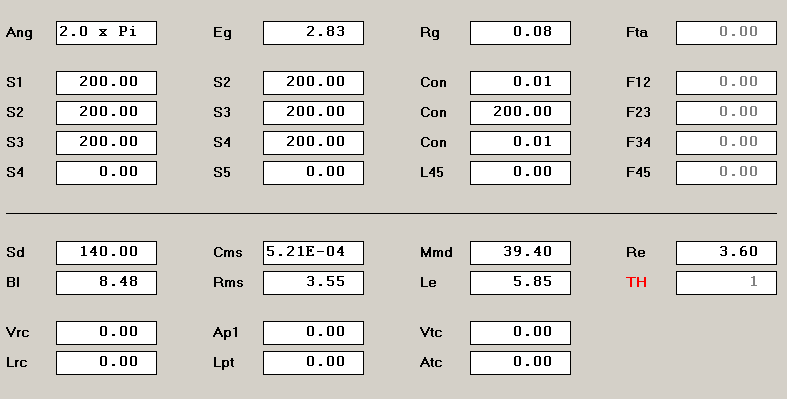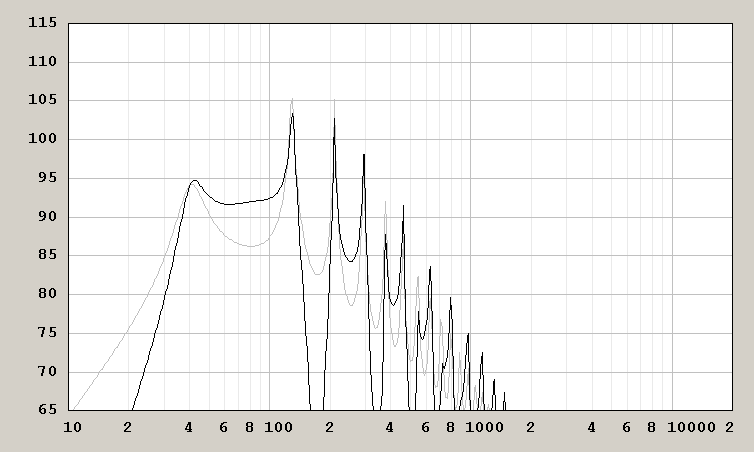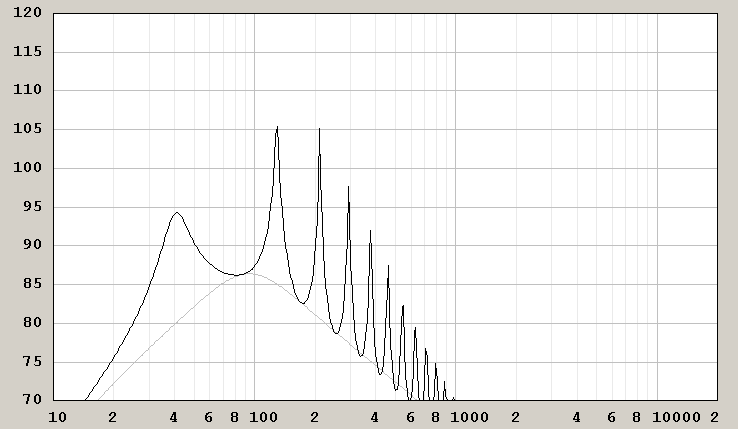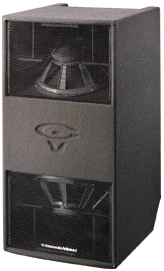In other words, the TH arrangement can give you a significantly better SPL response without adding much to the stress on the driver or amplifier.
If we're going to be comparing SPL like that, shouldn't we be using HornResp's "combined response" feature to get a truer picture of the OD's overall response?
Don Hills -
I am very grateful for your efforts and patience. For the moment, I hesitate to turn to a "black box" like HornResp and would rather have a good feel for the issues rather than accept some concept on authority, even from the authority of a computer!
I find it very odd to see resonances and anti-resonances at 45, 70, and 120 since these are not harmonically related. Can you explain that, please? Or are we talking about a collection of judiciously selected drivers and pipe dimensions that result in a satisfactory output?
Interesting that you indicate that the TH output is built up from a grab-bag of artfully crafted resonances. By long audiophile instinct, I am allergic to resonances anywhere they raise their (ordinarily) ugly heads. I suppose that closely spaced deep bass resonances are hard to tell apart from an authentically flat response speaker (that pretty much nobody can make by any means, by the way).
Further, with speakers stimulated, for example, by Danley's excellent fireworks recording and all the favorite organ demos which, likewise, only the rarest of recordings have any even occasional content below 37 Hz, everybody mistakes that solid 40 Hz output for, say some kind of textbook-ultimate 20 Hz*. But I am cautious about the concept of trafficking in resonances to reproduce music faithfully and without self-characteristic color.
*My Klipschorn is as great and soul-satisfying a wall- and floor-shaker as anybody could want; but it has little output below about 37. Would that describe a TH, even one with much smaller dimensions? Likewise some good-thumping Yorkville or EV PA speakers which don't go low at all.
I am very grateful for your efforts and patience. For the moment, I hesitate to turn to a "black box" like HornResp and would rather have a good feel for the issues rather than accept some concept on authority, even from the authority of a computer!
I find it very odd to see resonances and anti-resonances at 45, 70, and 120 since these are not harmonically related. Can you explain that, please? Or are we talking about a collection of judiciously selected drivers and pipe dimensions that result in a satisfactory output?
Interesting that you indicate that the TH output is built up from a grab-bag of artfully crafted resonances. By long audiophile instinct, I am allergic to resonances anywhere they raise their (ordinarily) ugly heads. I suppose that closely spaced deep bass resonances are hard to tell apart from an authentically flat response speaker (that pretty much nobody can make by any means, by the way).
Further, with speakers stimulated, for example, by Danley's excellent fireworks recording and all the favorite organ demos which, likewise, only the rarest of recordings have any even occasional content below 37 Hz, everybody mistakes that solid 40 Hz output for, say some kind of textbook-ultimate 20 Hz*. But I am cautious about the concept of trafficking in resonances to reproduce music faithfully and without self-characteristic color.
*My Klipschorn is as great and soul-satisfying a wall- and floor-shaker as anybody could want; but it has little output below about 37. Would that describe a TH, even one with much smaller dimensions? Likewise some good-thumping Yorkville or EV PA speakers which don't go low at all.
Last edited:
I find it very odd to see resonances and anti-resonances at 45, 70, and 120 since these are not harmonically related. Can you explain that, please? Or are we talking about a collection of judiciously selected drivers and pipe dimensions that result in a satisfactory output?
This isn't the best horn to use as an example, but lets run with it. Horns are quarter wave resonators just like pipes. Unfortunately, the flare makes the math a pain. To start off lets take the Volvotreter TH, and convert it into a TPipe.

Now the resonances are determined by the quarter wavelength of the length of the pipe. In this case 2m. Now as this is a pipe with one end open, and one end closed it is known as a closed-end air column. This means it will only have odd order harmonics. The peaks you see are these harmonics. (Most any physics book will explain a lot better than I can.) This is the math to figure out where the harmonics will be:
1st H = (4/1)*Column L
3rd H = (4/3)*CL
5th H = (4/5)*CL, and so on..
Now go Speed of Sound/H_= Hertz.
In this case we get:
(4/1)*2m= 8 ... 343/8= 42.875Hz H1
(4/3)*2m= 2.67 ... 343/8= 128.625Hz H3
(4/5)*2m= 1.6 ... 343/8= 214.375Hz H5
You can verify the math in HR:


Black is the TH, and gray is an OD.
This also shows how you trade bandwidth up top for some at the bottom in a TH.
Now if you use Volt's actual TH you get H1-36.5, H3-109.4, and H5-182.3
You will find that is is a little off, but close. This is because the simplified math doesn't take the flare rate and mouth end correction into account.
There is also something else to learn here. There are no anti-resonances. The dips seen are just areas were the harmonics do not yet overlap. Here is the same setup, only converted into a sealed enclosure of 100l.

The black is the OD Pipe from above, the gray is a sealed enclosure.
All horns work this way. The trick is to get the flare right to fill in the areas between the peaks.
I forgot to add that if you are looking for what is filling in the dips in a TH compare it to the sealed enclosure.
Take the sealed versions output at the dip, and then add 6dB to it. 3db for doubling the cone area, and 3db for doubling the power. Yes, you didn't add any power, but you didn't halve it either did you? 😉
Now all you have to do is position the tap in the right spot to be in phase at the correct time.
Notice in the last post that the Tapped Pipe goes in-phase then out-o-phase as it moves up the frequency tree passing the various resonances. 🙂
Take the sealed versions output at the dip, and then add 6dB to it. 3db for doubling the cone area, and 3db for doubling the power. Yes, you didn't add any power, but you didn't halve it either did you? 😉
Now all you have to do is position the tap in the right spot to be in phase at the correct time.
Notice in the last post that the Tapped Pipe goes in-phase then out-o-phase as it moves up the frequency tree passing the various resonances. 🙂
Last edited:
The new soho54 numbers (36.5, 109.4, and 182.3 and 42.875, 128.625, and 214.375) are close to simple harmonics, which relates to what I can barely remember about pipes. But previous numbers (45, 70, 120) aren't. How come?
BTW, you can't be in phase all the time, as soho54 says - that is like perpetual motion.
Why aren't we seeing cancellations when the rear-of-cone wave is out of phase with stuff coming downstream, particularly when the wave at the mouth is at a low in pressure? Danley gives the sound output "credit" for waves running up and then back down the horn... but I'm not sure the analogy to a stopped organ pipe is correct.
BTW, you can't be in phase all the time, as soho54 says - that is like perpetual motion.
Why aren't we seeing cancellations when the rear-of-cone wave is out of phase with stuff coming downstream, particularly when the wave at the mouth is at a low in pressure? Danley gives the sound output "credit" for waves running up and then back down the horn... but I'm not sure the analogy to a stopped organ pipe is correct.
Last edited:
He was giving node, anti-node, node. Forget the 70 from that. If you set the voltage to 0 you can clearly see the harmonics without any influence in the FR graph. They will show up as H1-43.5hZ, H3-111.5Hz, and H5-183Hz The discrepancy is caused by the flare rate and mouth of the horn. You can account for this and get closer numbers, but the math is something I can't do off the top of my head. 😀 The true acoustic path length of the horn is different from the length of the parts, because of the interaction between the horn and the outside pressures at the mouths transitional boundary.The new soho54 numbers (36.5, 109.4, and 182.3 and 42.875, 128.625, and 214.375) are close to simple harmonics, which relates to what I can barely remember about pipes. But previous numbers (45, 70, 120) aren't. How come?
Now if you throw the voltage back into the equation the FR peaks will move around again. The horn's low corner will be ~45Hz, the next peak is now at 120Hz, with the third at 183Hz. This is caused by the interaction between the drivers two sides, and the driver/tap positions within the horn. This is also a pain to figure out in any simple way, but it can be done.
I said this was not a good example for just these reasons. This is more of a TL with the taps brute forced to give good results. A lot of the driver in mouth THs are like this. It helps to look at them as a Bandpass with the horn as the coupling chamber, and the driver front and rear taps as the two ports into it. The closer to a true horn, the better the peaks will match up. In any I have done the peaks are in the same positions.
We are, it just isn't really something that stands out. If you look back at my my TP and OD Pipe picture you will see the TP's tap is messing with the magnitude of the resonance peaks above the first one when compared to the ODP, as well as the low/dip areas. In a true horn the same thing happens, only the flare makes it more jumbled. The lower in frequency the larger the waves involved, and the more mixed up/smoothed over it gets.Why aren't we seeing cancellations when the rear-of-cone wave is out of phase with stuff coming downstream, particularly when the wave at the mouth is at a low in pressure? Danley gives the sound output "credit" for waves running up and then back down the horn... but I'm not sure the analogy to a stopped organ pipe is correct.
Last edited:
Sorry, if it wasn't apparent, but Volts horn is a little longer than my TPipe. I changed the length a little to better show the difference with the TP and ODP versions.
The simple resonance numbers for the Volt are 36.5, 109.4, and 182.3.
The actual in horn numbers are 43.5, 111.5, and 183.
The numbers after the driver/tap influence is added are 45Hz, 120Hz, and 183Hz on the FR graph.
In post 24 it should read
(4/1)*2m= 8 ... 343/8= 42.875Hz H1
(4/3)*2m= 2.67 ... 343/2.67= 128.625Hz H3
(4/5)*2m= 1.6 ... 343/1.6= 214.375Hz H5
🙄
The simple resonance numbers for the Volt are 36.5, 109.4, and 182.3.
The actual in horn numbers are 43.5, 111.5, and 183.
The numbers after the driver/tap influence is added are 45Hz, 120Hz, and 183Hz on the FR graph.
In post 24 it should read
(4/1)*2m= 8 ... 343/8= 42.875Hz H1
(4/3)*2m= 2.67 ... 343/2.67= 128.625Hz H3
(4/5)*2m= 1.6 ... 343/1.6= 214.375Hz H5
🙄
Last edited:
The world would be a beautiful place if all replies were as excellent in tech talk and as comprehensible as soho54's. Thank you.
I'll try to digest this good stuff as best I can.
Personal note: looking like there's a lot of art resting on a TH concept that allows for a lot of creative fudging in TH design. That, once again, would make a purist itchy and make cookbook replication of results by quick-and-dirty DIYers tenuous. I understand now that Paul Klipsch's horn has a certain amount of creative fudging in it too. Only sealed boxes or maybe TLs leave little scope for art. But the proof of the pudding is in the tasting.
I'll try to digest this good stuff as best I can.
Personal note: looking like there's a lot of art resting on a TH concept that allows for a lot of creative fudging in TH design. That, once again, would make a purist itchy and make cookbook replication of results by quick-and-dirty DIYers tenuous. I understand now that Paul Klipsch's horn has a certain amount of creative fudging in it too. Only sealed boxes or maybe TLs leave little scope for art. But the proof of the pudding is in the tasting.
Last edited:
I really hate not being able to edit posts after a certain time here. What happened to the Mod Edit option?
I said this, "There are no anti-resonances" but that is not the correct wording. Inverse Even Order Harmonics would be more inline with what I meant. I see it explained/understood this way a lot, but it is misleading.
I was not trying to get into Impedance response there. 😉
I said this, "There are no anti-resonances" but that is not the correct wording. Inverse Even Order Harmonics would be more inline with what I meant. I see it explained/understood this way a lot, but it is misleading.
I was not trying to get into Impedance response there. 😉
1. Strange, why are there often 3 impedance peaks measured? What are the driver impedance (cone motion) peaks towards the bottom, how do these relate to wave/length/phase, and how to these relate to sound output?
2. How do you account for the high sound output (comparable the the enclosure-reinforcing levels you talk about) but found far north of them from say, 120 to 200 Hz?
Many thanks for your help... I am sure others appreciate it too.
You're welcome!
There's actually four or more depending on its tuning, i.e. tuned to Fs (simplest) down to a 1/2 WL below Fs. Remember, these are basically 6th (or in a few cases, 8th and 10th) order alignments, so in its simplest form, #1, #2 impedance peaks bracket the pipe/horn's fundamental resonance (Fo) with #2, #3 bracketing its tuning frequency (Fc) and #3, #4 its HF corner tuning. There can be a phase inversion between each one or linear through them all if there's enough acoustic loading. Sound output is the summed responses of the two systems same as any driver/box loading.
The horn's gain BW begins where it's acoustically a 1/2 WL long, hence the two stage response of many of the alignments since they are too short/small.
GM
This morning I was reading up on Eugene Czerwinski, from Cerwin Vega, and stumbled across this:

It looks like Cerwin Vega sold tapped horns for a while, or someone modified one of their boxes and accidentally made a tapped horn.
The boxes in question were used in theaters in the 70s for the movie "Earthquake."

These are the "original" Sensurround boxes, which are clearly front loaded horns. It's not 100% clear if the Cerwin Vega tapped horn was something that somebody hacked together, or an actual product. I can't find any specs on it, and just a single pic online. The Sensurround subs are the ones in the center of this pic.

Eugene Czerwinski was clearly exploring tapped horns and dipoles and co-entrant horns in the 90s, he has a few patents on them, now expired. The Unity horn patent cites this design from Czerwinski. Note how a second loudspeaker in the horn is used to change the overall response.
Here's the patent, from Y2K : US6038326A - Loudspeaker and horn with an additional transducer
- Google Patents

It looks like Cerwin Vega sold tapped horns for a while, or someone modified one of their boxes and accidentally made a tapped horn.
The boxes in question were used in theaters in the 70s for the movie "Earthquake."

These are the "original" Sensurround boxes, which are clearly front loaded horns. It's not 100% clear if the Cerwin Vega tapped horn was something that somebody hacked together, or an actual product. I can't find any specs on it, and just a single pic online. The Sensurround subs are the ones in the center of this pic.

Eugene Czerwinski was clearly exploring tapped horns and dipoles and co-entrant horns in the 90s, he has a few patents on them, now expired. The Unity horn patent cites this design from Czerwinski. Note how a second loudspeaker in the horn is used to change the overall response.
Here's the patent, from Y2K : US6038326A - Loudspeaker and horn with an additional transducer
- Google Patents
that dual 18 Cerwin-Vega model is mentioned here Earthquaking, Cerwin Vegas! - ecoustics.com
it may be relatively recent due to the logo routed into its front panel.
It appears to have been called "SUB-218" and fwiw one reference mentioned "2009"
DJzone LDI Coverage New Audio
Here apparently was its press description which I found over at Tiggersound
"The SUB-218 is a direct-radiating dual 18" subwoofer featuring high power handling and tremendous output down to 30 Hz. Performance of two subwoofers in one convenient package makes the SUB-218 a perfect choice for any installation requiring deep bass and high power handling. Mobile DJs will also appreciate the SUB-218’s wheels and stainless steel bar handle. Cerwin-Vega’s innovative horn-port system is coupled with two 18” woofers. Each woofer fires into a horn port with a specific flare rate for optimum tuning and an oversize horn mouth for increased radiation efficiency. The vent opening traverses the woofer’s motor ("Genesis-Exit"), cooling the magnet assembly and voice coil for increased power handling. The harder it is driven, the greater the cooling function!"

it may be relatively recent due to the logo routed into its front panel.
It appears to have been called "SUB-218" and fwiw one reference mentioned "2009"
DJzone LDI Coverage New Audio
Here apparently was its press description which I found over at Tiggersound
"The SUB-218 is a direct-radiating dual 18" subwoofer featuring high power handling and tremendous output down to 30 Hz. Performance of two subwoofers in one convenient package makes the SUB-218 a perfect choice for any installation requiring deep bass and high power handling. Mobile DJs will also appreciate the SUB-218’s wheels and stainless steel bar handle. Cerwin-Vega’s innovative horn-port system is coupled with two 18” woofers. Each woofer fires into a horn port with a specific flare rate for optimum tuning and an oversize horn mouth for increased radiation efficiency. The vent opening traverses the woofer’s motor ("Genesis-Exit"), cooling the magnet assembly and voice coil for increased power handling. The harder it is driven, the greater the cooling function!"

Last edited:
Big Vent Reflex?
Something similar to cubo-series. Electro-Voice mtl-1 has some similarities too, reflex with big flared port.
As far as I know, they do have more sensitivity at some point..
Last edited:
Speaking of BVRs.......
Freddy, got Bill Woods/RCA fan's 'Hit'/half horn pics from this [and other] threads? Mine are all locked up in a damaged HD:
High Efficiency Speaker Asylum
TIA,
GM
Freddy, got Bill Woods/RCA fan's 'Hit'/half horn pics from this [and other] threads? Mine are all locked up in a damaged HD:
High Efficiency Speaker Asylum
TIA,
GM
My prosound buddy went through the mtl phase on his way to his current FLH bottom end - 8 Labhorns. No going back to whumph from WHAM.
GM - dunno if pix survived - I had outdoor graphs of Bill Woods' "V-Vent" box vs a Karlson, both loaded with JBL M151 but those may be gone forever. Speaking of Bill's "Hitbox", I noticed the hornresp update from a couple of days ago would not allow changing segment fla
Bill's little hitbox vs stuff

Bill's little hitbox vs stuff

Last edited:
This morning I was reading up on Eugene Czerwinski, from Cerwin Vega, and stumbled across this:

It looks like Cerwin Vega sold tapped horns for a while, or someone modified one of their boxes and accidentally made a tapped horn.
The boxes in question were used in theaters in the 70s for the movie "Earthquake."

These are the "original" Sensurround boxes, which are clearly front loaded horns. It's not 100% clear if the Cerwin Vega tapped horn was something that somebody hacked together, or an actual product. I can't find any specs on it, and just a single pic online. The Sensurround subs are the ones in the center of this pic.

Eugene Czerwinski was clearly exploring tapped horns and dipoles and co-entrant horns in the 90s, he has a few patents on them, now expired. The Unity horn patent cites this design from Czerwinski. Note how a second loudspeaker in the horn is used to change the overall response.
Here's the patent, from Y2K : US6038326A - Loudspeaker and horn with an additional transducer
- Google Patents
and if you look around, djk explained the best way to make that work....and actually recommended the pyle 21"er for the dipole radiator. cerwinski and danley were playing with the same stuff at the same time but vega was well dead by then. when it got sold to gibson all patented and such information was not transferred. so no legacy support was offered on any product which is why all those surplus vega raw parts were everywhere for pennies on the dollar 15 years ago. literally everything was auctioned off.
that 2x18 is a reflex, with the ports firing over the driver. not dissimilar to the jl fathom you explored however long ago.
oh and the sensurround stuff, at least the subs were 100% flhs and that was when keele was playing around with cerwinski....ya know after he fixed the khorn....which lead to the v35 full range cabs and their cast biradial horns and "waveguided" 18"ers.
people crap on vega quite a bit, some of its deserved, but talk about a real legacy in both home and pro arenas. competed with klipsch in his hey day and took on jbl and EV in their prime.....at the same time!
people crap on vega quite a bit, some of its deserved, but talk about a real legacy in both home and pro arenas. competed with klipsch in his hey day and took on jbl and EV in their prime.....at the same time!
- Status
- Not open for further replies.
- Home
- Loudspeakers
- Subwoofers
- Evolution of the Tapped Horn